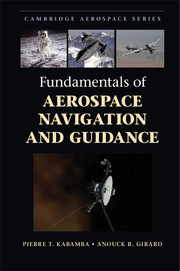Book contents
- Frontmatter
- Dedication
- Contents
- Preface
- 1 Introduction
- 2 Deterministic Systems Theory
- 3 Stochastic Systems Theory
- 4 Navigation
- 5 Homing Guidance
- 6 Ballistic Guidance
- 7 Midcourse Guidance
- 8 Optimization
- 9 Optimal Guidance
- 10 Introduction to Differential Games
- Epilogue
- APPENDIX A Useful Definitions and Mathematical Results
- Bibliography
- Index
Preface
Published online by Cambridge University Press: 05 October 2014
- Frontmatter
- Dedication
- Contents
- Preface
- 1 Introduction
- 2 Deterministic Systems Theory
- 3 Stochastic Systems Theory
- 4 Navigation
- 5 Homing Guidance
- 6 Ballistic Guidance
- 7 Midcourse Guidance
- 8 Optimization
- 9 Optimal Guidance
- 10 Introduction to Differential Games
- Epilogue
- APPENDIX A Useful Definitions and Mathematical Results
- Bibliography
- Index
Summary
This book arose out of lecture notes for the graduate-level course AE584 Guidance, Navigation, and Avionics, taught in the Department of Aerospace Engineering at the University of Michigan at Ann Arbor. The course was originally introduced by Professor Emeritus Robert M. Howe and was taught for a number of years by the authors.
This book can be used as a textbook supporting a graduate-level formal course on aerospace navigation and guidance. It can also be used as a guide for self-study on the subject. Finally, it can be used as a reference text. To enhance its usability, the book contains numerous examples illustrating concepts and homework problems at the end of all chapters. A partial solution manual for these homework problems is available with limited circulation.
Although this book uses many mathematical results, it is not a mathematics text. The results are stated with some rigor, but only a few proofs of special interest are given. The interested reader may consult the bibliography listed at the end of each chapter for proofs and additional information.
The prerequisite knowledge includes undergraduate instruction in elementary linear algebra, differential equations, and flight mechanics, which are standard in aerospace engineering curricula. Key definitions and mathematical results are given in the appendix.
The intended audience for this book encompasses graduate students in engineering specializing in flight dynamics, guidance, navigation, and control, together with practicing engineers and researchers in the field. In the authors’ experience, this text maps to a two-semester graduate sequence, with the first semester covering roughly the first six chapters and the second semester covering roughly the last four chapters.
- Type
- Chapter
- Information
- Fundamentals of Aerospace Navigation and Guidance , pp. xv - xviPublisher: Cambridge University PressPrint publication year: 2014

